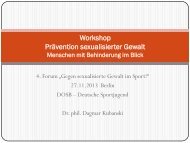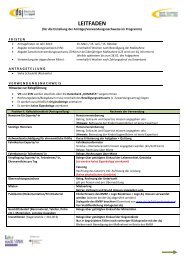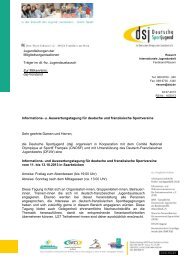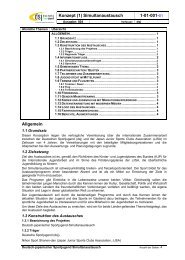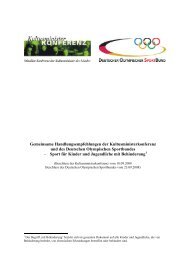Prevention of sexual and gender harassment and abuse in sports ...
Prevention of sexual and gender harassment and abuse in sports ...
Prevention of sexual and gender harassment and abuse in sports ...
You also want an ePaper? Increase the reach of your titles
YUMPU automatically turns print PDFs into web optimized ePapers that Google loves.
Detailed description <strong>of</strong> the <strong>in</strong>itiative: What problems were tackled?<br />
Based on their analysis <strong>of</strong> the documents they studied <strong>and</strong> the 27 <strong>in</strong>terviews, Parent <strong>and</strong><br />
Deners (2010) propose the above over-arch<strong>in</strong>g model to prevent <strong>sexual</strong> <strong>abuse</strong> <strong>in</strong> sport. They<br />
highlight the need to tackle the factors which prevent the effective implementation <strong>of</strong><br />
safeguard<strong>in</strong>g strategies. At the national level, they recommend the creation <strong>of</strong> a body to act as<br />
a resource for sport<strong>in</strong>g organisations. This body could design <strong>and</strong> provide tra<strong>in</strong><strong>in</strong>g, conduct<br />
awareness-rais<strong>in</strong>g activities <strong>and</strong> serve as a general reference po<strong>in</strong>t. Tra<strong>in</strong><strong>in</strong>g is also<br />
recommended for those work<strong>in</strong>g at federation <strong>and</strong> club level. Parent <strong>and</strong> Deners (2010) also<br />
highlight the need for both external <strong>and</strong> <strong>in</strong>ternal barriers. External barriers relate to the<br />
recruitment <strong>of</strong> personnel (e.g., background checks, recruitment procedures etc.). Internal<br />
barriers should be set up with<strong>in</strong> organisations to create a positive culture which prevents<br />
<strong>sexual</strong> <strong>abuse</strong> (e.g., through policies, tra<strong>in</strong><strong>in</strong>g <strong>and</strong> procedures).<br />
It is argued that the adoption <strong>of</strong> this model would address the range <strong>of</strong> factors which detract<br />
from effective implementation <strong>of</strong> prevention strategies. These <strong>in</strong>clude:<br />
1. A negative view <strong>of</strong> prevention – key stakeholders were found to trivialise the impact<br />
<strong>and</strong> effectiveness <strong>of</strong> measures. There was also some concern that the measures would<br />
lead to a perception that there must be an underly<strong>in</strong>g problem;<br />
2. Lack <strong>of</strong> leadership – <strong>abuse</strong> prevention was viewed as a low-priority issue, <strong>and</strong> this view<br />
was reflected <strong>in</strong> the resources <strong>and</strong> personnel targeted at prevention;<br />
3. Reactive approach – it <strong>of</strong>ten took an actual case to make organisations realise that they<br />
were not equipped to deal with the issue. This resulted <strong>in</strong> reactive rather than proactive<br />
measures;<br />
4. Little pre-employment screen<strong>in</strong>g – it was reported that volunteers were not subjected to<br />
any background checks prior to work<strong>in</strong>g with young people;<br />
5. Lack <strong>of</strong> tra<strong>in</strong><strong>in</strong>g for stakeholders – it was observed that participants had not received<br />
any tra<strong>in</strong><strong>in</strong>g regard<strong>in</strong>g the prevention <strong>of</strong> <strong>sexual</strong> <strong>abuse</strong> <strong>in</strong> sport;<br />
6. Unclear <strong>in</strong>terpersonal boundaries – there was a lack <strong>of</strong> consensus <strong>in</strong> terms <strong>of</strong> the k<strong>in</strong>ds<br />
<strong>of</strong> behaviours which were <strong>and</strong> were not appropriate;<br />
43



